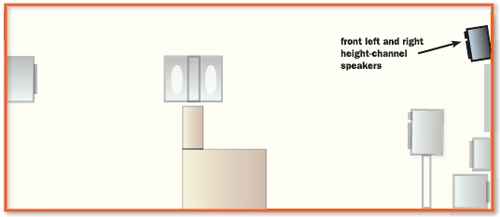How To Get The Most Out Of Your Speakers Page 3
 For a 7.1-channel setup, two direct-radiating speakers are placed on the back wall, firing towards the listening position. (A 6.1-channel setup uses a single back speaker.) In larger rooms, a second subwoofer can be used along with the first.
For a 7.1-channel setup, two direct-radiating speakers are placed on the back wall, firing towards the listening position. (A 6.1-channel setup uses a single back speaker.) In larger rooms, a second subwoofer can be used along with the first.
Subwoofers: Plumbing The Depths
The main thing to remember when positioning a subwoofer is that putting it in a bass-cancellation area will eliminate much of the bass, while placing it in an area that reinforces bass might make it sound boomy. Experiment with placement, but even though frequencies below 100 Hz are considered to be largely nondirectional, locating the subwoofer too far from the main speakers might cause imaging to suffer.
Here's an old audiophile trick: Set the subwoofer on a table near the listening position, so that its driver is at the same height as your ears would be if you were sitting there. Then crawl around the room on your hands and knees (oh, the things we do for good sound), listening to the bass at the same height the subwoofer will be at when it's placed on the floor. When you've found the spot where the bass sounds the tightest - not boomy or undefined - put the subwoofer there.
If you have the space and the budget, using two subwoofers can provide a more even low-frequency response over a wider listening area.
Dolby Pro Logic IIz: Scaling New Heights
One of the latest advancements in multichannel audio is Dolby Pro Logic IIz. This format employs left- and right-front height-channel speakers in addition to a 5.1-, 6.1-, or 7.1-channel configuration. The height speakers reproduce the nondirectional elements in the audio mix and add a vertical dimension to the sound field that can provide, well, heightened realism to movie soundtracks, music, and games. The speakers are placed on stands or attached to the wall and are positioned above the left and right front speakers. Also, keep in mind that you'll need a receiver with Dolby Pro Logic IIz capability.
Bellying Up To The Soundbar
Integrated, all-in-one left/center/right speakers, or soundbars, have become increasingly prevalent because they combine the three front channels into a sleek, space-saving configuration. They come in two main varieties - a basic three-speakers-in-one design, which is essentially three individual speakers in a combined enclosure, and "virtual surround"-type models, which feature built-in signal processing to create a sense of hearing sound from behind you as well as from the front. With either type, make sure the soundbar is centered above or below the TV and aimed toward the listening position.
 For Dolby Pro Logic IIz, two height-channel speakers are placed on stands or attached to the wall and positioned above the front right and left speakers.
For Dolby Pro Logic IIz, two height-channel speakers are placed on stands or attached to the wall and positioned above the front right and left speakers.
Wireless Speakers And Subwoofers
What if you want a surround sound speaker system but can't run wires through the walls, ceilings, or floors, or under carpets, to your surround speakers or sub? Wireless speakers and subwoofers are the answer. While going wireless eliminates having to run speaker wires or a subwoofer cable from your receiver, you'll still have to plug the wireless speakers or subwoofer into an AC outlet. Early wireless speakers sounded pretty poor, but there are now many good sounding models to choose from.
What About In-Wall And Ceiling Speakers?
In-wall, ceiling, and slim-profile on-wall speakers are more popular then ever for obvious reasons - they take up no floor space and can be almost invisible. Keep them symmetrical, and follow the rules for direct-radiating vs. dipole/bipole speaker placement. The speakers should be mounted with the tweeters at (or close to) ear level, and in the case of adjustable ceiling speakers, should be aimed to provide seamless, even sound coverage at the listening position.
Fine-Tuning Your Setup
Once you've gotten your speakers in place, you need to do three things:
? Adjust your receiver to match your speaker setup. (You'll calibrate for the number of speakers and subwoofers in your system and whether they're large or small.)
? Time-align all the speakers to compensate for the varying distances from the speakers to the listening position.
? Balance the speakers' volume levels so they're all heard at equal volume.
All of this is done using the receiver's speaker-setup or bassmanagement menu. Don't ignore this step! It pains me to think of people simply hooking up their receivers and speakers out of the box and never optimizing their setup - and many receivers can even do these adjustments for you automatically.
A little extra effort in setting up your speakers pays off big in the enjoyment you'll get out of your home theater or music system. Don't just take my word for it - the proof is in the listening!
- Log in or register to post comments





























































